Analyzing Play-Based Learning: Early Years Teaching Strategies
VerifiedAdded on 2023/06/11
|11
|2451
|101
Essay
AI Summary
This essay examines the role of play in early years teaching, focusing on pedagogical actions, conceptual reciprocity, and the creation of safe and stimulating learning environments. It integrates theoretical frameworks such as the cultural-historical concept of play and sustained shared thinking, linking them to practical examples from a child-care center. The essay also discusses the importance of aligning teaching practices with the Victorian Early Years Learning and Development Framework (VEYLDF) and the Early Years Learning Framework for Australia (EYLF), emphasizing the need to consider a child's perspective in the learning process. The author reflects on personal experiences and views, highlighting the significance of play in fostering children's understanding of the world and acquiring knowledge from peers and mentors, while also addressing the importance of educators facilitating and adapting to children's interests.
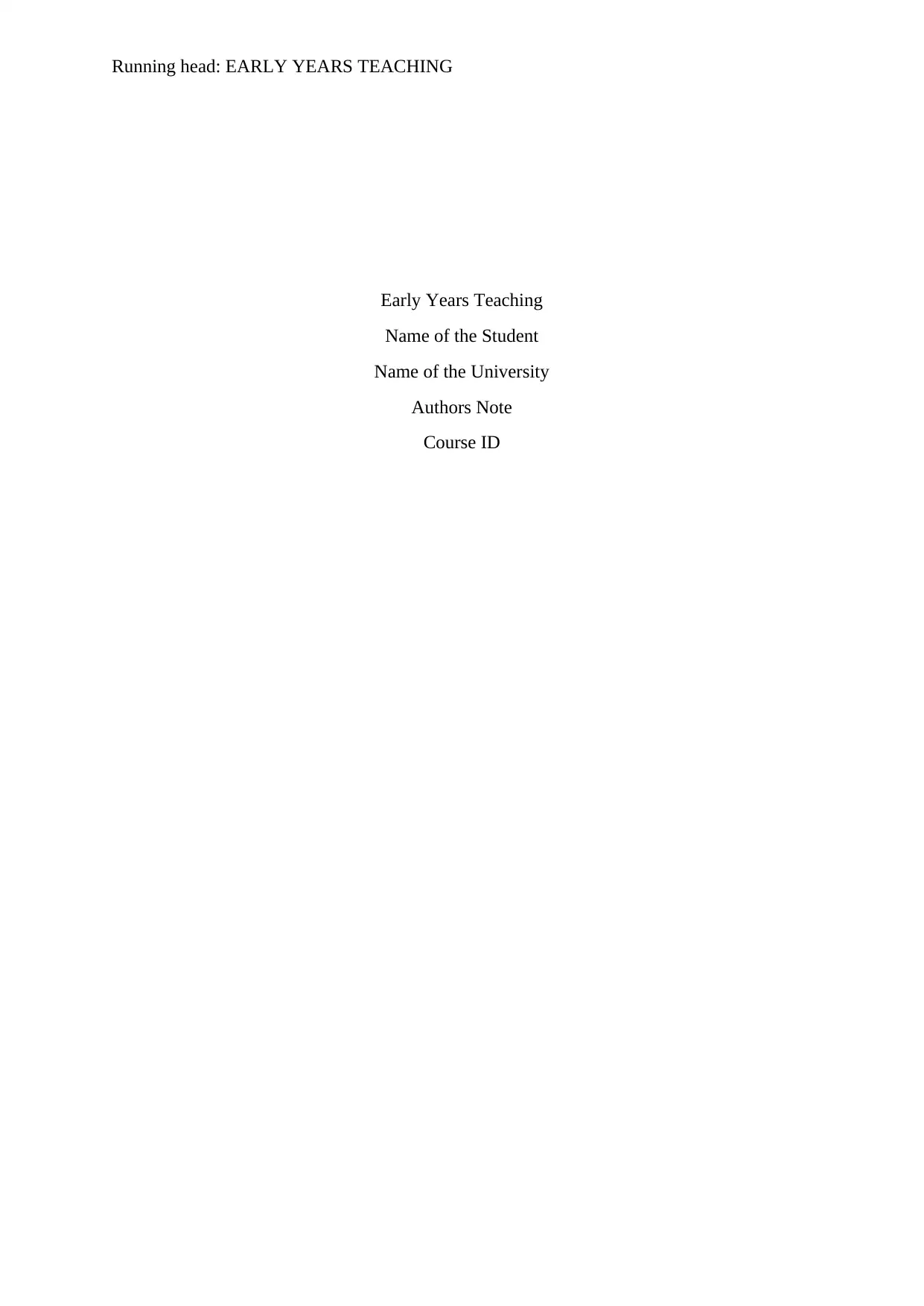
Running head: EARLY YEARS TEACHING
Early Years Teaching
Name of the Student
Name of the University
Authors Note
Course ID
Early Years Teaching
Name of the Student
Name of the University
Authors Note
Course ID
Secure Best Marks with AI Grader
Need help grading? Try our AI Grader for instant feedback on your assignments.
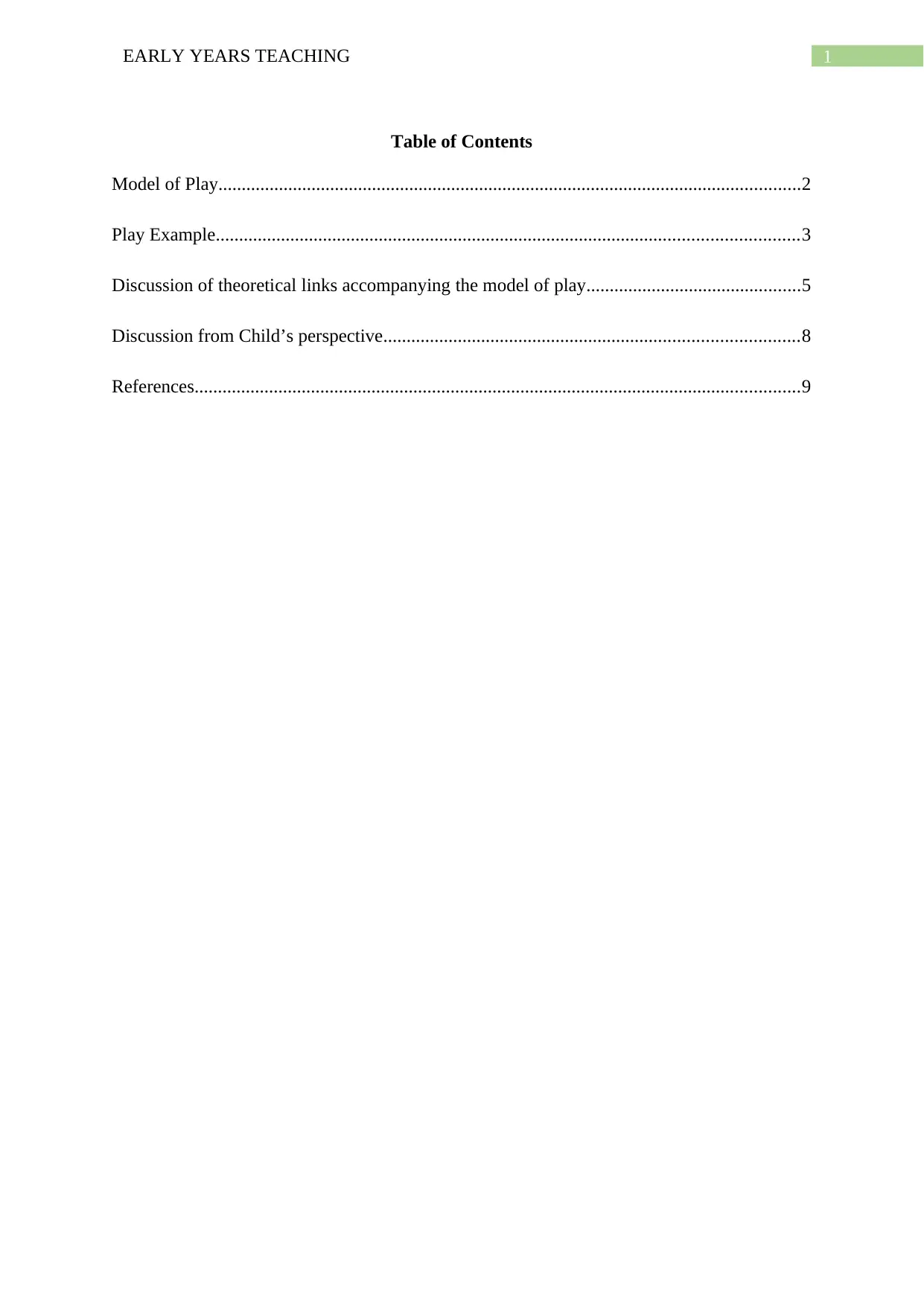
1EARLY YEARS TEACHING
Table of Contents
Model of Play.............................................................................................................................2
Play Example.............................................................................................................................3
Discussion of theoretical links accompanying the model of play..............................................5
Discussion from Child’s perspective.........................................................................................8
References..................................................................................................................................9
Table of Contents
Model of Play.............................................................................................................................2
Play Example.............................................................................................................................3
Discussion of theoretical links accompanying the model of play..............................................5
Discussion from Child’s perspective.........................................................................................8
References..................................................................................................................................9
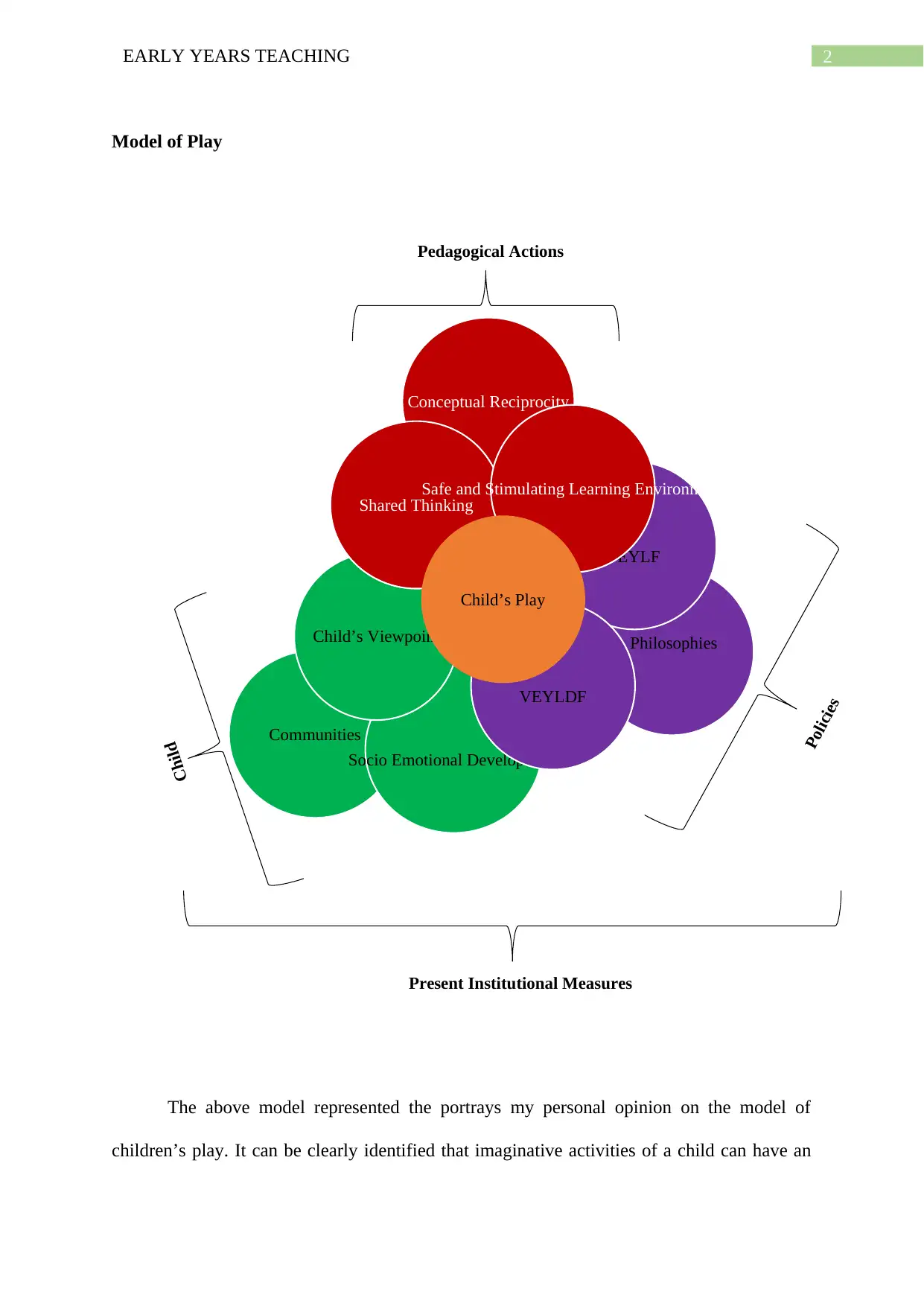
2EARLY YEARS TEACHING
Communities
Socio Emotional Development
Conceptual Reciprocity
Child’s Viewpoint
Shared Thinking
Philosophies
EYLF
Safe and Stimulating Learning Environment
VEYLDF
Child’s Play
Policies
Pedagogical Actions
Child
Present Institutional Measures
Model of Play
The above model represented the portrays my personal opinion on the model of
children’s play. It can be clearly identified that imaginative activities of a child can have an
Communities
Socio Emotional Development
Conceptual Reciprocity
Child’s Viewpoint
Shared Thinking
Philosophies
EYLF
Safe and Stimulating Learning Environment
VEYLDF
Child’s Play
Policies
Pedagogical Actions
Child
Present Institutional Measures
Model of Play
The above model represented the portrays my personal opinion on the model of
children’s play. It can be clearly identified that imaginative activities of a child can have an
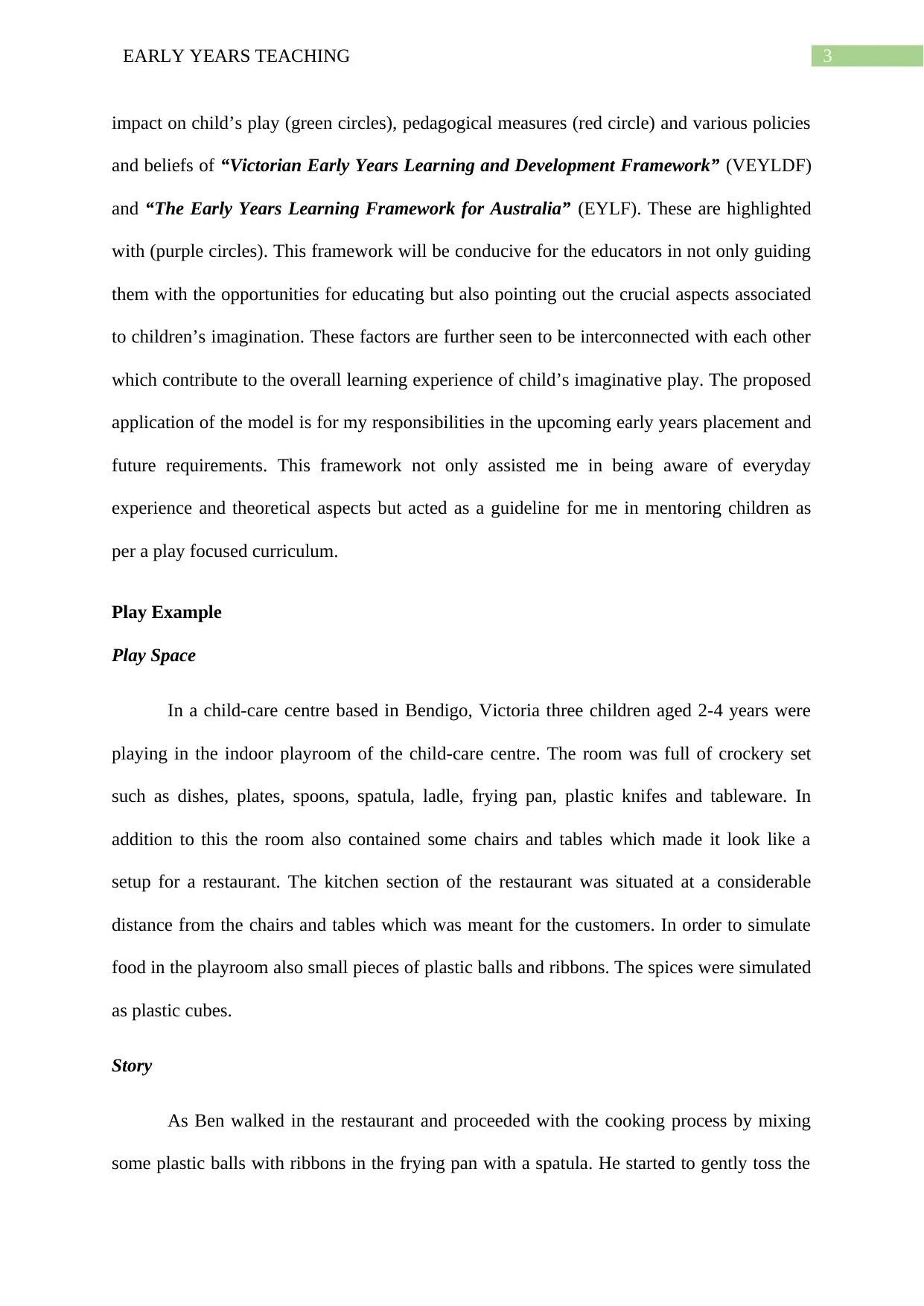
3EARLY YEARS TEACHING
impact on child’s play (green circles), pedagogical measures (red circle) and various policies
and beliefs of “Victorian Early Years Learning and Development Framework” (VEYLDF)
and “The Early Years Learning Framework for Australia” (EYLF). These are highlighted
with (purple circles). This framework will be conducive for the educators in not only guiding
them with the opportunities for educating but also pointing out the crucial aspects associated
to children’s imagination. These factors are further seen to be interconnected with each other
which contribute to the overall learning experience of child’s imaginative play. The proposed
application of the model is for my responsibilities in the upcoming early years placement and
future requirements. This framework not only assisted me in being aware of everyday
experience and theoretical aspects but acted as a guideline for me in mentoring children as
per a play focused curriculum.
Play Example
Play Space
In a child-care centre based in Bendigo, Victoria three children aged 2-4 years were
playing in the indoor playroom of the child-care centre. The room was full of crockery set
such as dishes, plates, spoons, spatula, ladle, frying pan, plastic knifes and tableware. In
addition to this the room also contained some chairs and tables which made it look like a
setup for a restaurant. The kitchen section of the restaurant was situated at a considerable
distance from the chairs and tables which was meant for the customers. In order to simulate
food in the playroom also small pieces of plastic balls and ribbons. The spices were simulated
as plastic cubes.
Story
As Ben walked in the restaurant and proceeded with the cooking process by mixing
some plastic balls with ribbons in the frying pan with a spatula. He started to gently toss the
impact on child’s play (green circles), pedagogical measures (red circle) and various policies
and beliefs of “Victorian Early Years Learning and Development Framework” (VEYLDF)
and “The Early Years Learning Framework for Australia” (EYLF). These are highlighted
with (purple circles). This framework will be conducive for the educators in not only guiding
them with the opportunities for educating but also pointing out the crucial aspects associated
to children’s imagination. These factors are further seen to be interconnected with each other
which contribute to the overall learning experience of child’s imaginative play. The proposed
application of the model is for my responsibilities in the upcoming early years placement and
future requirements. This framework not only assisted me in being aware of everyday
experience and theoretical aspects but acted as a guideline for me in mentoring children as
per a play focused curriculum.
Play Example
Play Space
In a child-care centre based in Bendigo, Victoria three children aged 2-4 years were
playing in the indoor playroom of the child-care centre. The room was full of crockery set
such as dishes, plates, spoons, spatula, ladle, frying pan, plastic knifes and tableware. In
addition to this the room also contained some chairs and tables which made it look like a
setup for a restaurant. The kitchen section of the restaurant was situated at a considerable
distance from the chairs and tables which was meant for the customers. In order to simulate
food in the playroom also small pieces of plastic balls and ribbons. The spices were simulated
as plastic cubes.
Story
As Ben walked in the restaurant and proceeded with the cooking process by mixing
some plastic balls with ribbons in the frying pan with a spatula. He started to gently toss the
Secure Best Marks with AI Grader
Need help grading? Try our AI Grader for instant feedback on your assignments.
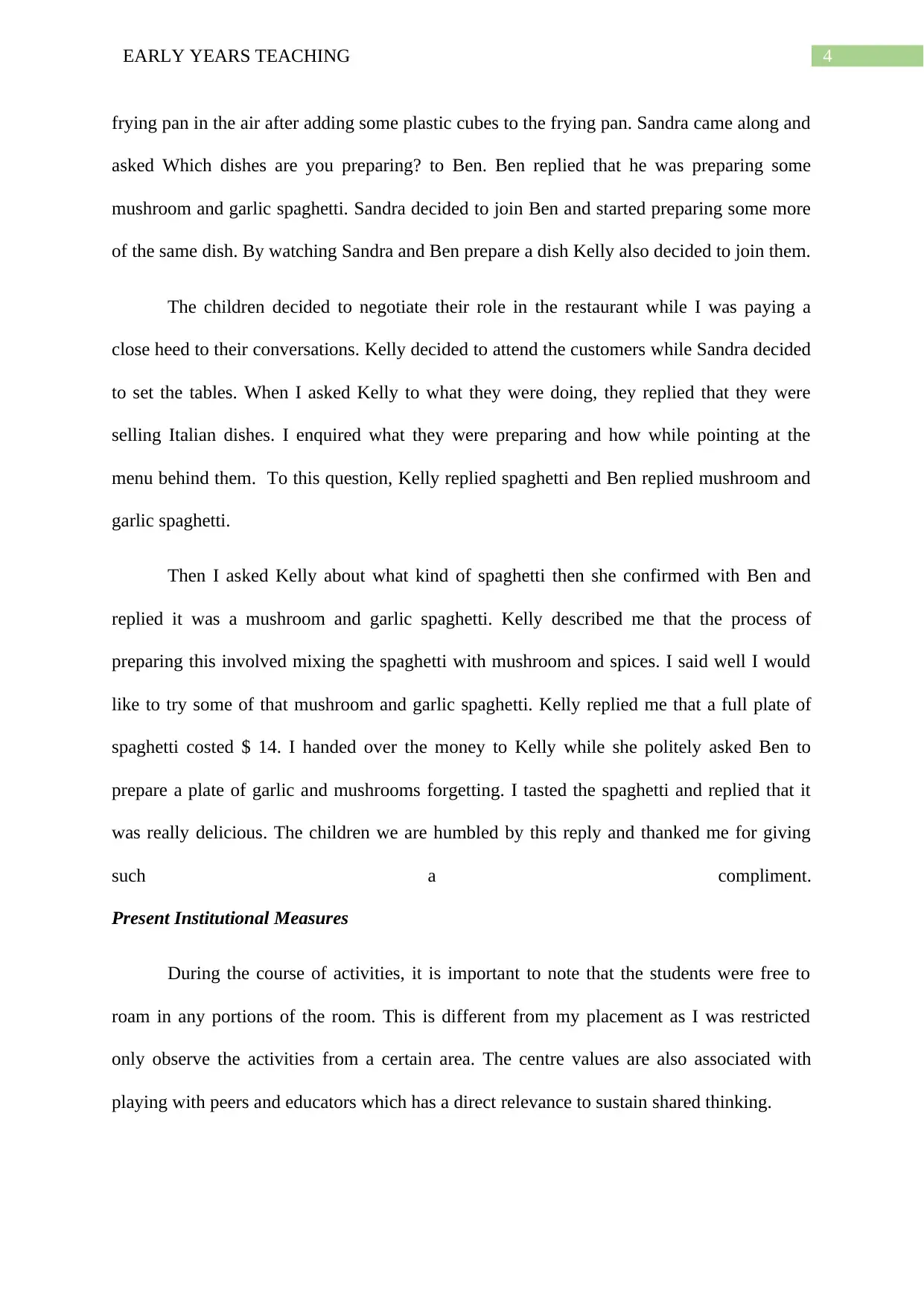
4EARLY YEARS TEACHING
frying pan in the air after adding some plastic cubes to the frying pan. Sandra came along and
asked Which dishes are you preparing? to Ben. Ben replied that he was preparing some
mushroom and garlic spaghetti. Sandra decided to join Ben and started preparing some more
of the same dish. By watching Sandra and Ben prepare a dish Kelly also decided to join them.
The children decided to negotiate their role in the restaurant while I was paying a
close heed to their conversations. Kelly decided to attend the customers while Sandra decided
to set the tables. When I asked Kelly to what they were doing, they replied that they were
selling Italian dishes. I enquired what they were preparing and how while pointing at the
menu behind them. To this question, Kelly replied spaghetti and Ben replied mushroom and
garlic spaghetti.
Then I asked Kelly about what kind of spaghetti then she confirmed with Ben and
replied it was a mushroom and garlic spaghetti. Kelly described me that the process of
preparing this involved mixing the spaghetti with mushroom and spices. I said well I would
like to try some of that mushroom and garlic spaghetti. Kelly replied me that a full plate of
spaghetti costed $ 14. I handed over the money to Kelly while she politely asked Ben to
prepare a plate of garlic and mushrooms forgetting. I tasted the spaghetti and replied that it
was really delicious. The children we are humbled by this reply and thanked me for giving
such a compliment.
Present Institutional Measures
During the course of activities, it is important to note that the students were free to
roam in any portions of the room. This is different from my placement as I was restricted
only observe the activities from a certain area. The centre values are also associated with
playing with peers and educators which has a direct relevance to sustain shared thinking.
frying pan in the air after adding some plastic cubes to the frying pan. Sandra came along and
asked Which dishes are you preparing? to Ben. Ben replied that he was preparing some
mushroom and garlic spaghetti. Sandra decided to join Ben and started preparing some more
of the same dish. By watching Sandra and Ben prepare a dish Kelly also decided to join them.
The children decided to negotiate their role in the restaurant while I was paying a
close heed to their conversations. Kelly decided to attend the customers while Sandra decided
to set the tables. When I asked Kelly to what they were doing, they replied that they were
selling Italian dishes. I enquired what they were preparing and how while pointing at the
menu behind them. To this question, Kelly replied spaghetti and Ben replied mushroom and
garlic spaghetti.
Then I asked Kelly about what kind of spaghetti then she confirmed with Ben and
replied it was a mushroom and garlic spaghetti. Kelly described me that the process of
preparing this involved mixing the spaghetti with mushroom and spices. I said well I would
like to try some of that mushroom and garlic spaghetti. Kelly replied me that a full plate of
spaghetti costed $ 14. I handed over the money to Kelly while she politely asked Ben to
prepare a plate of garlic and mushrooms forgetting. I tasted the spaghetti and replied that it
was really delicious. The children we are humbled by this reply and thanked me for giving
such a compliment.
Present Institutional Measures
During the course of activities, it is important to note that the students were free to
roam in any portions of the room. This is different from my placement as I was restricted
only observe the activities from a certain area. The centre values are also associated with
playing with peers and educators which has a direct relevance to sustain shared thinking.
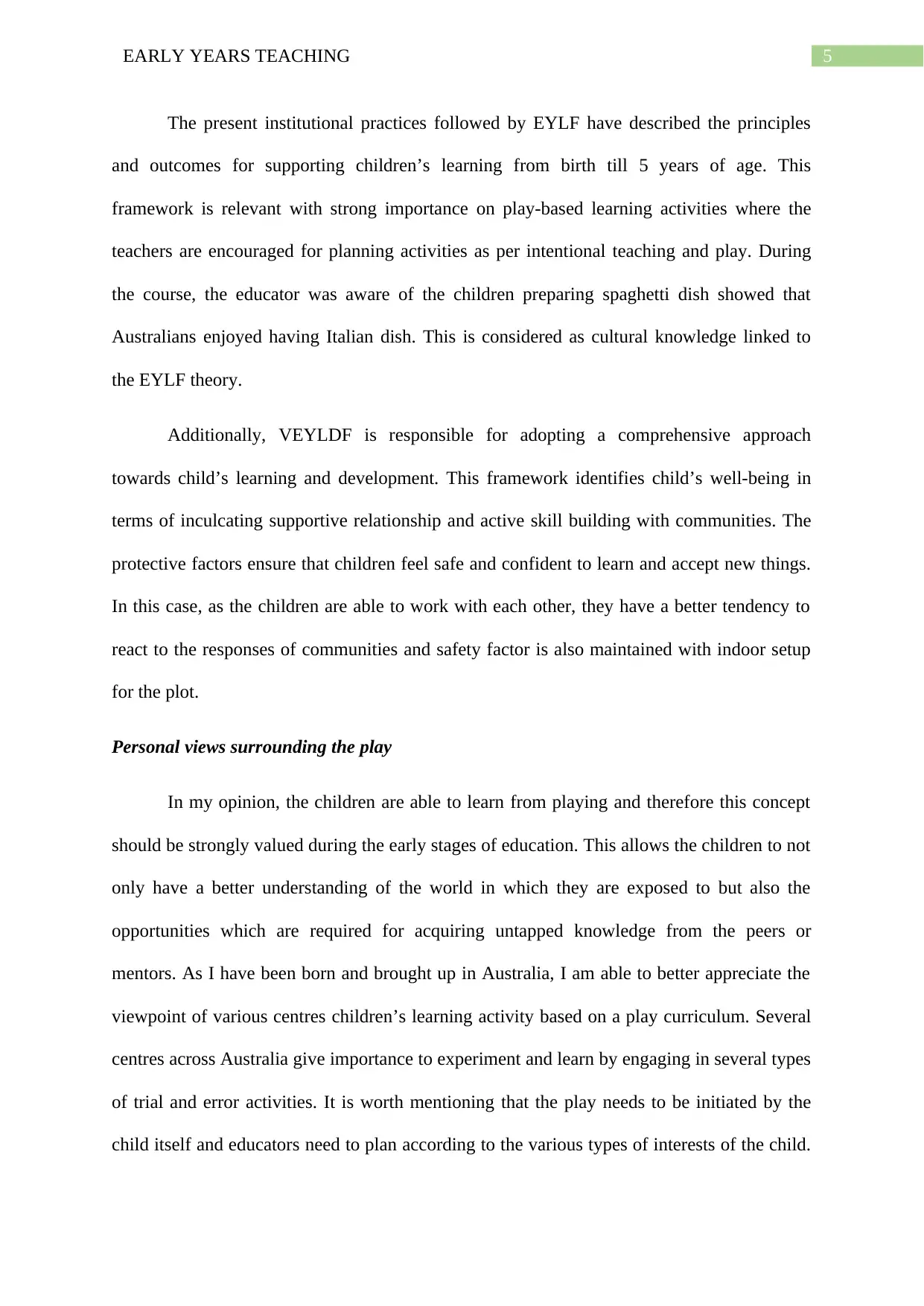
5EARLY YEARS TEACHING
The present institutional practices followed by EYLF have described the principles
and outcomes for supporting children’s learning from birth till 5 years of age. This
framework is relevant with strong importance on play-based learning activities where the
teachers are encouraged for planning activities as per intentional teaching and play. During
the course, the educator was aware of the children preparing spaghetti dish showed that
Australians enjoyed having Italian dish. This is considered as cultural knowledge linked to
the EYLF theory.
Additionally, VEYLDF is responsible for adopting a comprehensive approach
towards child’s learning and development. This framework identifies child’s well-being in
terms of inculcating supportive relationship and active skill building with communities. The
protective factors ensure that children feel safe and confident to learn and accept new things.
In this case, as the children are able to work with each other, they have a better tendency to
react to the responses of communities and safety factor is also maintained with indoor setup
for the plot.
Personal views surrounding the play
In my opinion, the children are able to learn from playing and therefore this concept
should be strongly valued during the early stages of education. This allows the children to not
only have a better understanding of the world in which they are exposed to but also the
opportunities which are required for acquiring untapped knowledge from the peers or
mentors. As I have been born and brought up in Australia, I am able to better appreciate the
viewpoint of various centres children’s learning activity based on a play curriculum. Several
centres across Australia give importance to experiment and learn by engaging in several types
of trial and error activities. It is worth mentioning that the play needs to be initiated by the
child itself and educators need to plan according to the various types of interests of the child.
The present institutional practices followed by EYLF have described the principles
and outcomes for supporting children’s learning from birth till 5 years of age. This
framework is relevant with strong importance on play-based learning activities where the
teachers are encouraged for planning activities as per intentional teaching and play. During
the course, the educator was aware of the children preparing spaghetti dish showed that
Australians enjoyed having Italian dish. This is considered as cultural knowledge linked to
the EYLF theory.
Additionally, VEYLDF is responsible for adopting a comprehensive approach
towards child’s learning and development. This framework identifies child’s well-being in
terms of inculcating supportive relationship and active skill building with communities. The
protective factors ensure that children feel safe and confident to learn and accept new things.
In this case, as the children are able to work with each other, they have a better tendency to
react to the responses of communities and safety factor is also maintained with indoor setup
for the plot.
Personal views surrounding the play
In my opinion, the children are able to learn from playing and therefore this concept
should be strongly valued during the early stages of education. This allows the children to not
only have a better understanding of the world in which they are exposed to but also the
opportunities which are required for acquiring untapped knowledge from the peers or
mentors. As I have been born and brought up in Australia, I am able to better appreciate the
viewpoint of various centres children’s learning activity based on a play curriculum. Several
centres across Australia give importance to experiment and learn by engaging in several types
of trial and error activities. It is worth mentioning that the play needs to be initiated by the
child itself and educators need to plan according to the various types of interests of the child.
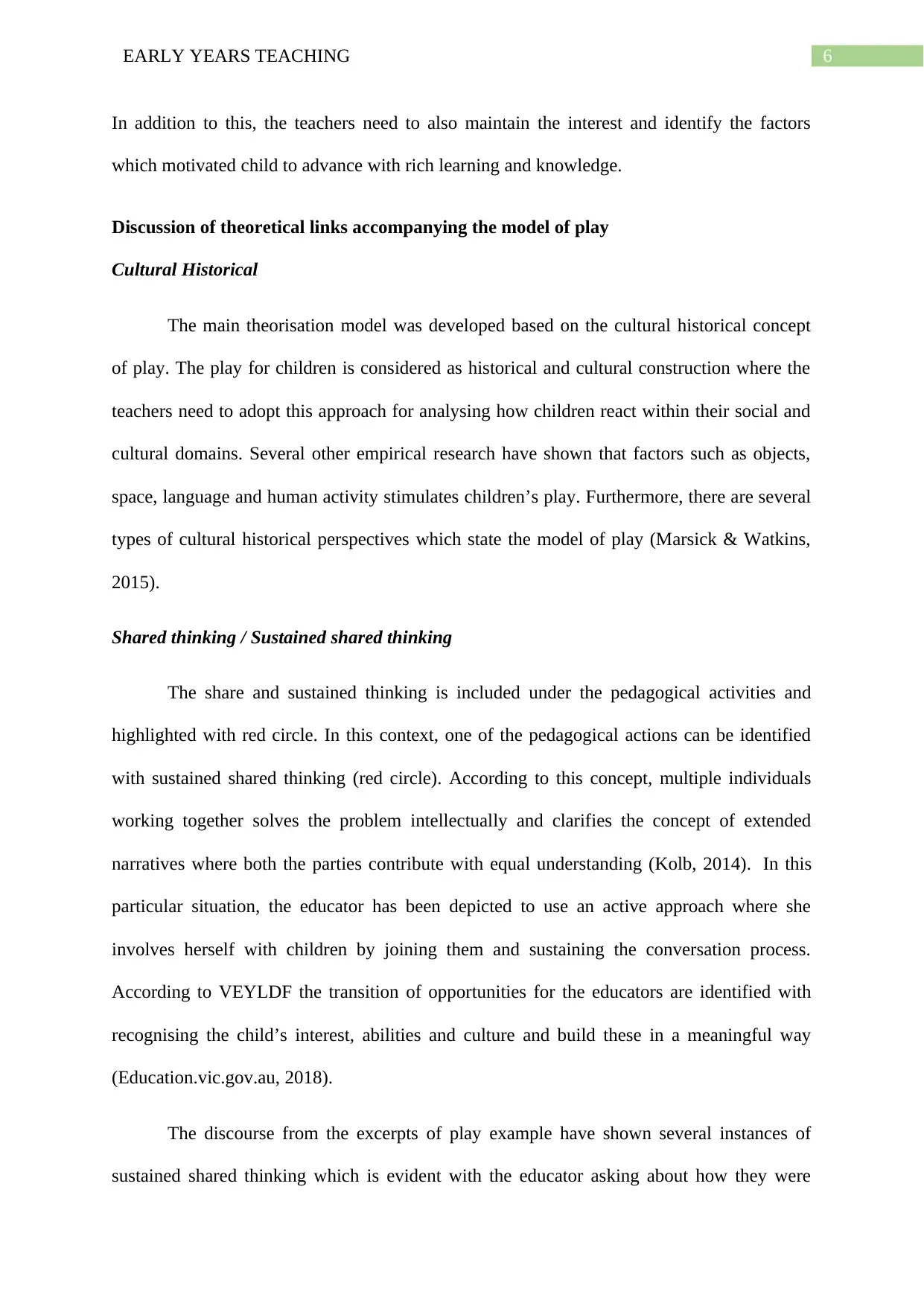
6EARLY YEARS TEACHING
In addition to this, the teachers need to also maintain the interest and identify the factors
which motivated child to advance with rich learning and knowledge.
Discussion of theoretical links accompanying the model of play
Cultural Historical
The main theorisation model was developed based on the cultural historical concept
of play. The play for children is considered as historical and cultural construction where the
teachers need to adopt this approach for analysing how children react within their social and
cultural domains. Several other empirical research have shown that factors such as objects,
space, language and human activity stimulates children’s play. Furthermore, there are several
types of cultural historical perspectives which state the model of play (Marsick & Watkins,
2015).
Shared thinking / Sustained shared thinking
The share and sustained thinking is included under the pedagogical activities and
highlighted with red circle. In this context, one of the pedagogical actions can be identified
with sustained shared thinking (red circle). According to this concept, multiple individuals
working together solves the problem intellectually and clarifies the concept of extended
narratives where both the parties contribute with equal understanding (Kolb, 2014). In this
particular situation, the educator has been depicted to use an active approach where she
involves herself with children by joining them and sustaining the conversation process.
According to VEYLDF the transition of opportunities for the educators are identified with
recognising the child’s interest, abilities and culture and build these in a meaningful way
(Education.vic.gov.au, 2018).
The discourse from the excerpts of play example have shown several instances of
sustained shared thinking which is evident with the educator asking about how they were
In addition to this, the teachers need to also maintain the interest and identify the factors
which motivated child to advance with rich learning and knowledge.
Discussion of theoretical links accompanying the model of play
Cultural Historical
The main theorisation model was developed based on the cultural historical concept
of play. The play for children is considered as historical and cultural construction where the
teachers need to adopt this approach for analysing how children react within their social and
cultural domains. Several other empirical research have shown that factors such as objects,
space, language and human activity stimulates children’s play. Furthermore, there are several
types of cultural historical perspectives which state the model of play (Marsick & Watkins,
2015).
Shared thinking / Sustained shared thinking
The share and sustained thinking is included under the pedagogical activities and
highlighted with red circle. In this context, one of the pedagogical actions can be identified
with sustained shared thinking (red circle). According to this concept, multiple individuals
working together solves the problem intellectually and clarifies the concept of extended
narratives where both the parties contribute with equal understanding (Kolb, 2014). In this
particular situation, the educator has been depicted to use an active approach where she
involves herself with children by joining them and sustaining the conversation process.
According to VEYLDF the transition of opportunities for the educators are identified with
recognising the child’s interest, abilities and culture and build these in a meaningful way
(Education.vic.gov.au, 2018).
The discourse from the excerpts of play example have shown several instances of
sustained shared thinking which is evident with the educator asking about how they were
Paraphrase This Document
Need a fresh take? Get an instant paraphrase of this document with our AI Paraphraser
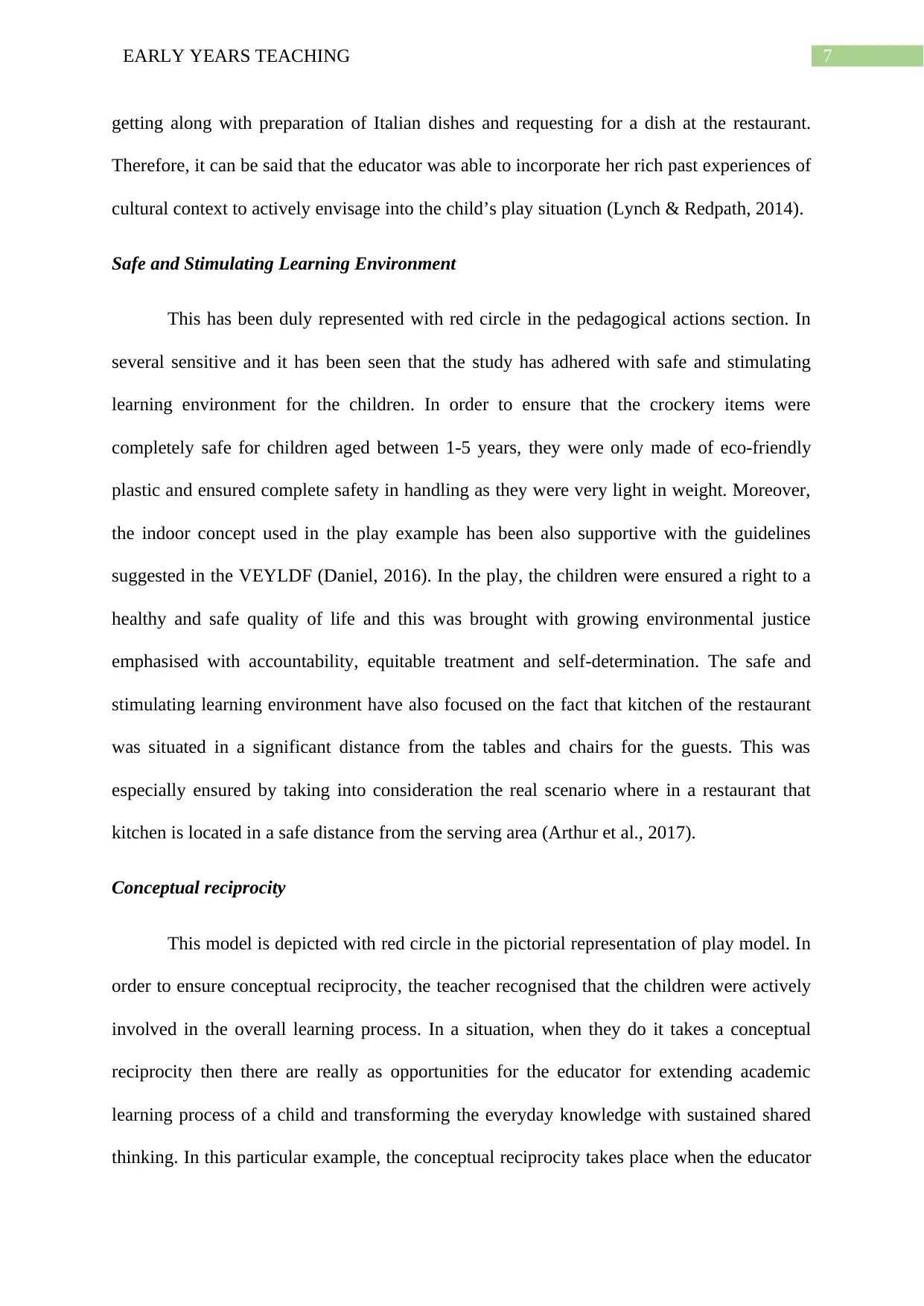
7EARLY YEARS TEACHING
getting along with preparation of Italian dishes and requesting for a dish at the restaurant.
Therefore, it can be said that the educator was able to incorporate her rich past experiences of
cultural context to actively envisage into the child’s play situation (Lynch & Redpath, 2014).
Safe and Stimulating Learning Environment
This has been duly represented with red circle in the pedagogical actions section. In
several sensitive and it has been seen that the study has adhered with safe and stimulating
learning environment for the children. In order to ensure that the crockery items were
completely safe for children aged between 1-5 years, they were only made of eco-friendly
plastic and ensured complete safety in handling as they were very light in weight. Moreover,
the indoor concept used in the play example has been also supportive with the guidelines
suggested in the VEYLDF (Daniel, 2016). In the play, the children were ensured a right to a
healthy and safe quality of life and this was brought with growing environmental justice
emphasised with accountability, equitable treatment and self-determination. The safe and
stimulating learning environment have also focused on the fact that kitchen of the restaurant
was situated in a significant distance from the tables and chairs for the guests. This was
especially ensured by taking into consideration the real scenario where in a restaurant that
kitchen is located in a safe distance from the serving area (Arthur et al., 2017).
Conceptual reciprocity
This model is depicted with red circle in the pictorial representation of play model. In
order to ensure conceptual reciprocity, the teacher recognised that the children were actively
involved in the overall learning process. In a situation, when they do it takes a conceptual
reciprocity then there are really as opportunities for the educator for extending academic
learning process of a child and transforming the everyday knowledge with sustained shared
thinking. In this particular example, the conceptual reciprocity takes place when the educator
getting along with preparation of Italian dishes and requesting for a dish at the restaurant.
Therefore, it can be said that the educator was able to incorporate her rich past experiences of
cultural context to actively envisage into the child’s play situation (Lynch & Redpath, 2014).
Safe and Stimulating Learning Environment
This has been duly represented with red circle in the pedagogical actions section. In
several sensitive and it has been seen that the study has adhered with safe and stimulating
learning environment for the children. In order to ensure that the crockery items were
completely safe for children aged between 1-5 years, they were only made of eco-friendly
plastic and ensured complete safety in handling as they were very light in weight. Moreover,
the indoor concept used in the play example has been also supportive with the guidelines
suggested in the VEYLDF (Daniel, 2016). In the play, the children were ensured a right to a
healthy and safe quality of life and this was brought with growing environmental justice
emphasised with accountability, equitable treatment and self-determination. The safe and
stimulating learning environment have also focused on the fact that kitchen of the restaurant
was situated in a significant distance from the tables and chairs for the guests. This was
especially ensured by taking into consideration the real scenario where in a restaurant that
kitchen is located in a safe distance from the serving area (Arthur et al., 2017).
Conceptual reciprocity
This model is depicted with red circle in the pictorial representation of play model. In
order to ensure conceptual reciprocity, the teacher recognised that the children were actively
involved in the overall learning process. In a situation, when they do it takes a conceptual
reciprocity then there are really as opportunities for the educator for extending academic
learning process of a child and transforming the everyday knowledge with sustained shared
thinking. In this particular example, the conceptual reciprocity takes place when the educator
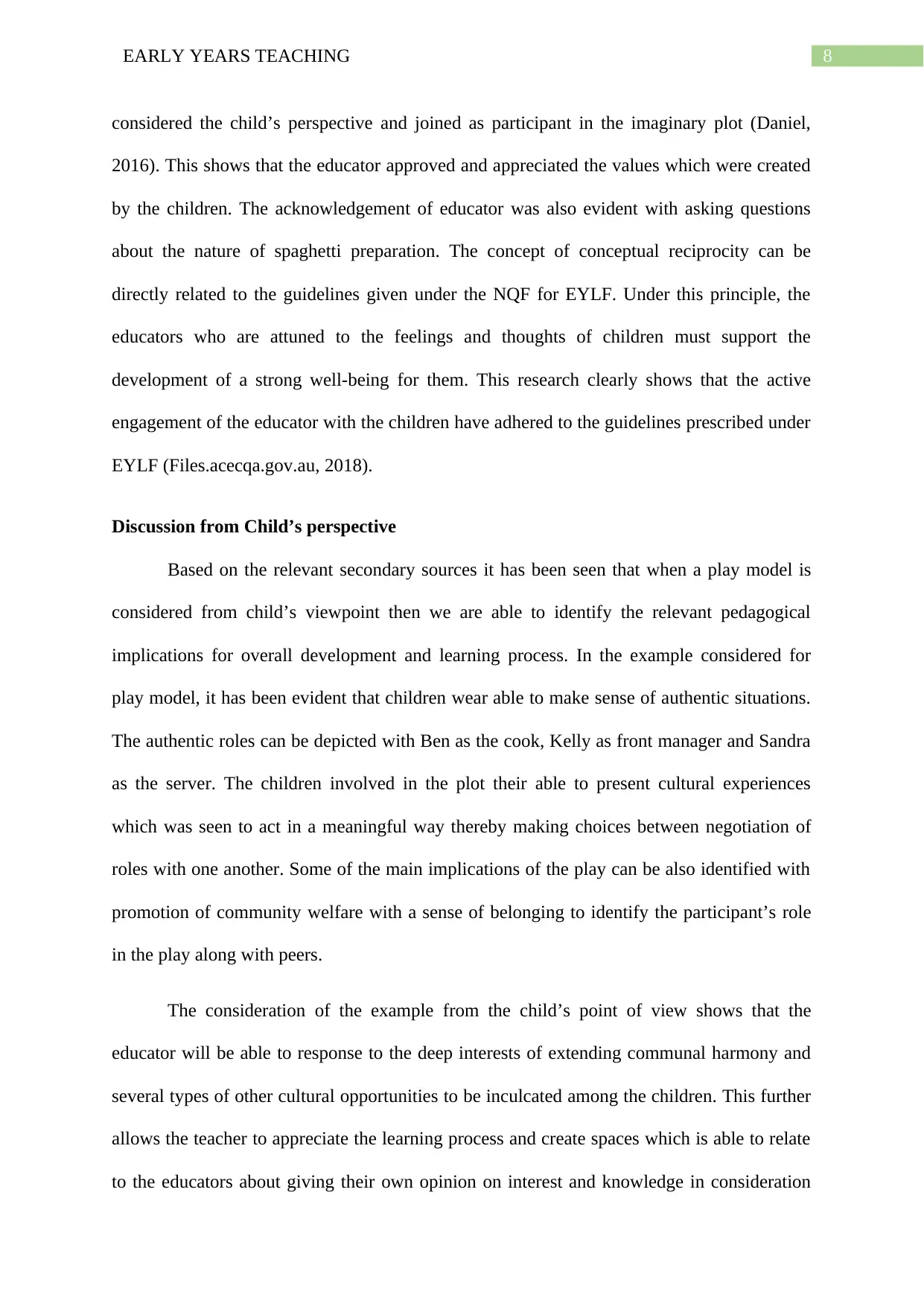
8EARLY YEARS TEACHING
considered the child’s perspective and joined as participant in the imaginary plot (Daniel,
2016). This shows that the educator approved and appreciated the values which were created
by the children. The acknowledgement of educator was also evident with asking questions
about the nature of spaghetti preparation. The concept of conceptual reciprocity can be
directly related to the guidelines given under the NQF for EYLF. Under this principle, the
educators who are attuned to the feelings and thoughts of children must support the
development of a strong well-being for them. This research clearly shows that the active
engagement of the educator with the children have adhered to the guidelines prescribed under
EYLF (Files.acecqa.gov.au, 2018).
Discussion from Child’s perspective
Based on the relevant secondary sources it has been seen that when a play model is
considered from child’s viewpoint then we are able to identify the relevant pedagogical
implications for overall development and learning process. In the example considered for
play model, it has been evident that children wear able to make sense of authentic situations.
The authentic roles can be depicted with Ben as the cook, Kelly as front manager and Sandra
as the server. The children involved in the plot their able to present cultural experiences
which was seen to act in a meaningful way thereby making choices between negotiation of
roles with one another. Some of the main implications of the play can be also identified with
promotion of community welfare with a sense of belonging to identify the participant’s role
in the play along with peers.
The consideration of the example from the child’s point of view shows that the
educator will be able to response to the deep interests of extending communal harmony and
several types of other cultural opportunities to be inculcated among the children. This further
allows the teacher to appreciate the learning process and create spaces which is able to relate
to the educators about giving their own opinion on interest and knowledge in consideration
considered the child’s perspective and joined as participant in the imaginary plot (Daniel,
2016). This shows that the educator approved and appreciated the values which were created
by the children. The acknowledgement of educator was also evident with asking questions
about the nature of spaghetti preparation. The concept of conceptual reciprocity can be
directly related to the guidelines given under the NQF for EYLF. Under this principle, the
educators who are attuned to the feelings and thoughts of children must support the
development of a strong well-being for them. This research clearly shows that the active
engagement of the educator with the children have adhered to the guidelines prescribed under
EYLF (Files.acecqa.gov.au, 2018).
Discussion from Child’s perspective
Based on the relevant secondary sources it has been seen that when a play model is
considered from child’s viewpoint then we are able to identify the relevant pedagogical
implications for overall development and learning process. In the example considered for
play model, it has been evident that children wear able to make sense of authentic situations.
The authentic roles can be depicted with Ben as the cook, Kelly as front manager and Sandra
as the server. The children involved in the plot their able to present cultural experiences
which was seen to act in a meaningful way thereby making choices between negotiation of
roles with one another. Some of the main implications of the play can be also identified with
promotion of community welfare with a sense of belonging to identify the participant’s role
in the play along with peers.
The consideration of the example from the child’s point of view shows that the
educator will be able to response to the deep interests of extending communal harmony and
several types of other cultural opportunities to be inculcated among the children. This further
allows the teacher to appreciate the learning process and create spaces which is able to relate
to the educators about giving their own opinion on interest and knowledge in consideration
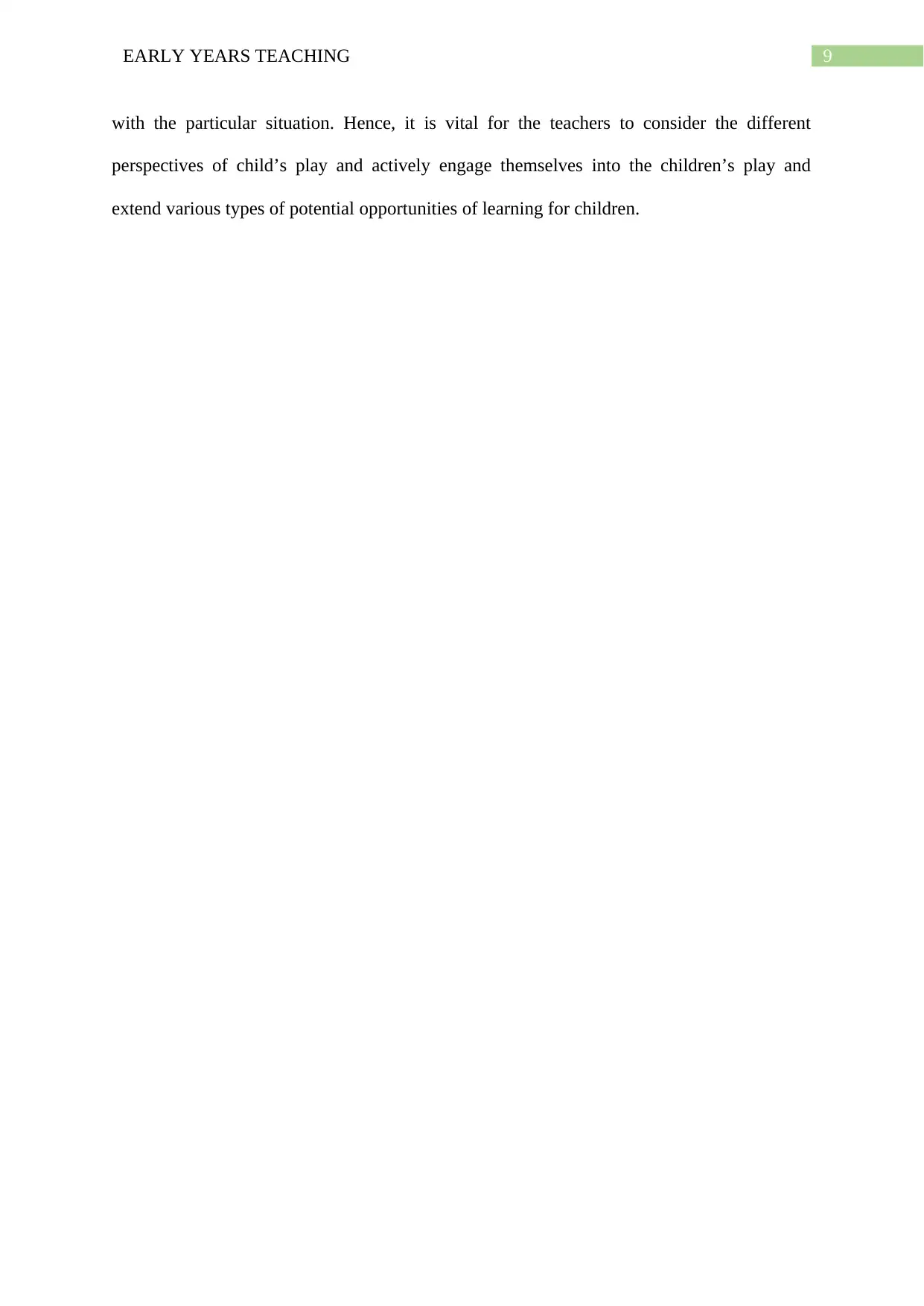
9EARLY YEARS TEACHING
with the particular situation. Hence, it is vital for the teachers to consider the different
perspectives of child’s play and actively engage themselves into the children’s play and
extend various types of potential opportunities of learning for children.
with the particular situation. Hence, it is vital for the teachers to consider the different
perspectives of child’s play and actively engage themselves into the children’s play and
extend various types of potential opportunities of learning for children.
Secure Best Marks with AI Grader
Need help grading? Try our AI Grader for instant feedback on your assignments.
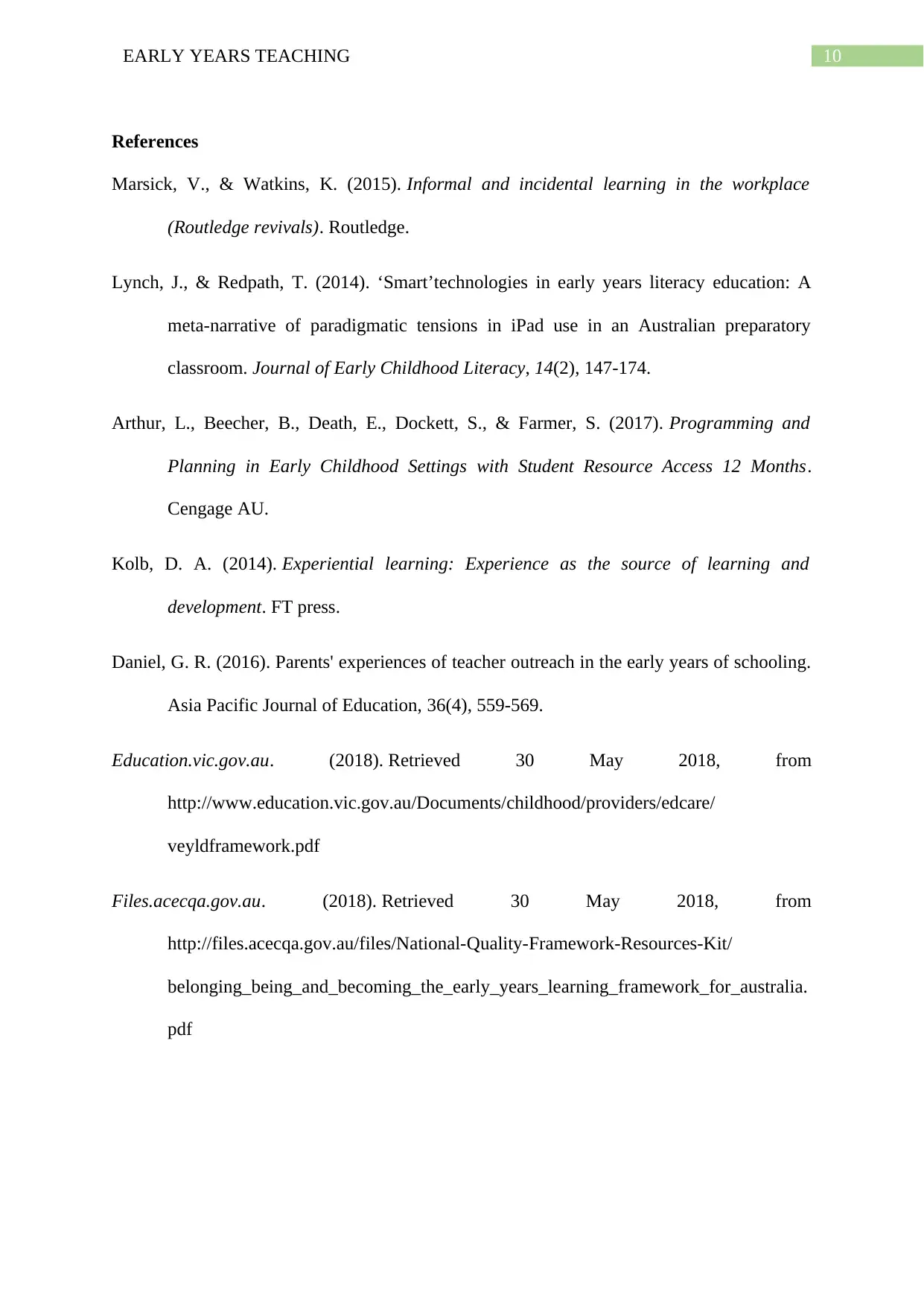
10EARLY YEARS TEACHING
References
Marsick, V., & Watkins, K. (2015). Informal and incidental learning in the workplace
(Routledge revivals). Routledge.
Lynch, J., & Redpath, T. (2014). ‘Smart’technologies in early years literacy education: A
meta-narrative of paradigmatic tensions in iPad use in an Australian preparatory
classroom. Journal of Early Childhood Literacy, 14(2), 147-174.
Arthur, L., Beecher, B., Death, E., Dockett, S., & Farmer, S. (2017). Programming and
Planning in Early Childhood Settings with Student Resource Access 12 Months.
Cengage AU.
Kolb, D. A. (2014). Experiential learning: Experience as the source of learning and
development. FT press.
Daniel, G. R. (2016). Parents' experiences of teacher outreach in the early years of schooling.
Asia Pacific Journal of Education, 36(4), 559-569.
Education.vic.gov.au. (2018). Retrieved 30 May 2018, from
http://www.education.vic.gov.au/Documents/childhood/providers/edcare/
veyldframework.pdf
Files.acecqa.gov.au. (2018). Retrieved 30 May 2018, from
http://files.acecqa.gov.au/files/National-Quality-Framework-Resources-Kit/
belonging_being_and_becoming_the_early_years_learning_framework_for_australia.
pdf
References
Marsick, V., & Watkins, K. (2015). Informal and incidental learning in the workplace
(Routledge revivals). Routledge.
Lynch, J., & Redpath, T. (2014). ‘Smart’technologies in early years literacy education: A
meta-narrative of paradigmatic tensions in iPad use in an Australian preparatory
classroom. Journal of Early Childhood Literacy, 14(2), 147-174.
Arthur, L., Beecher, B., Death, E., Dockett, S., & Farmer, S. (2017). Programming and
Planning in Early Childhood Settings with Student Resource Access 12 Months.
Cengage AU.
Kolb, D. A. (2014). Experiential learning: Experience as the source of learning and
development. FT press.
Daniel, G. R. (2016). Parents' experiences of teacher outreach in the early years of schooling.
Asia Pacific Journal of Education, 36(4), 559-569.
Education.vic.gov.au. (2018). Retrieved 30 May 2018, from
http://www.education.vic.gov.au/Documents/childhood/providers/edcare/
veyldframework.pdf
Files.acecqa.gov.au. (2018). Retrieved 30 May 2018, from
http://files.acecqa.gov.au/files/National-Quality-Framework-Resources-Kit/
belonging_being_and_becoming_the_early_years_learning_framework_for_australia.
1 out of 11
Your All-in-One AI-Powered Toolkit for Academic Success.
+13062052269
info@desklib.com
Available 24*7 on WhatsApp / Email
![[object Object]](/_next/static/media/star-bottom.7253800d.svg)
Unlock your academic potential
© 2024 | Zucol Services PVT LTD | All rights reserved.